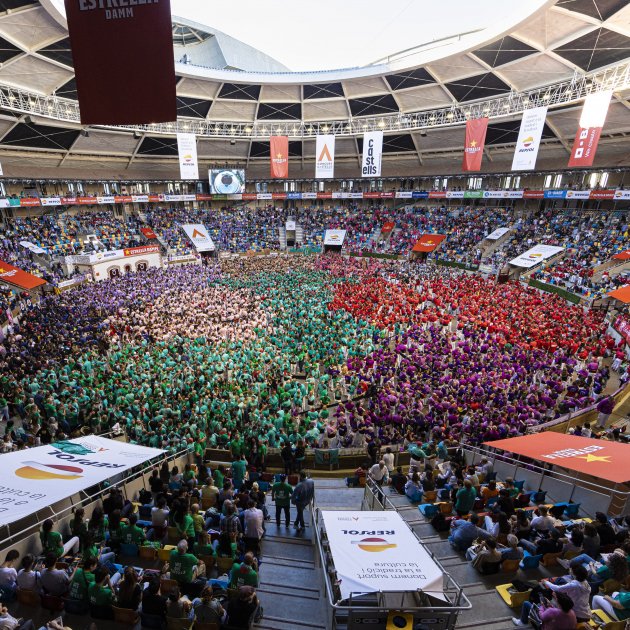A full-to-the-brim Tàrraco Arena Plaça has hosted the biggest event in the spectacular Catalan sport of castells, or human tower building. The biennial Concurs de Castells event returned on Sunday after an absence of four years, with the 2020 edition cancelled due to the Covid pandemic, and after more than six and a half hours of breathtaking construction and some fearful falls, an old champion reclaimed its lost crown. At ten in the morning, before the castles started to go up, the Catalan anthem Els Segadors was played, chants of "Independence!" broke out, and a giant Estelada flag was passed over the heads of the castellers on the floor of the stadium and up into the stands, which were still filling up. More than 11,000 people arrived - half of whom are members of the human tower groups - to watch or take part in the biggest casteller spectacle in the world.
The top twelve casteller groups of the moment took part in the contest, and the predictions of a fierce fight for first place between the Castellers de Vilafranca - winners of eight consecutive editions between 2002 and 2016 - and La Vella de Valls - champions in 2018 - proved correct, although a third group also came between them. The groups entered the arena from nine in the morning, their arrival announced by the gralles, traditional Catalan woodwind instruments, turning the arena into a large multicoloured tapestry.
From their first construction, the Castellers de Vilafranca showed they were the team to beat. Their first tower was in fact the best effort seen all day: a 3 de 10 amb folre i manilles - which means a castle 10 levels high, with 3 people at all the middle levels, and two heavily-packed base levels, the folre and manilles on top of the usual basement mass, the pinya. But then they fell behind in the second round with a 4 de 10 which failed. Nevertheless, they recovered in the following two rounds. First, with a 5 de 9 amb folre in the third round. In the fourth and final round, the Villafranca team decided the competition by putting up a 4 de 9 net - that is, a castle 9 storeys high, with four people at all levels from the second to the seventh. The net, meaning clean, is because it didn't have a folre or manilles! They fell on the way down too, losing points, but because they successfully erected that castle, the team in green from Vilafranca surged ahead of the Joves de Valls to achieve a total score of 8,485 points.
The Colla Vella dels Xiquets de Valls - that is, the "old" group of castellers from the town of Valls - started the day as reigning champions from the 2018 competition, but they were overshadowed by the "youngsters" from the same town - the Colla Joves Xiquets de Valls, who took second place with a total of 8,050 points thanks to the 4 de 9 net, which they put up and brought down in the first round - to get maximum points, you have to dismantle your castle correctly as well. Then they built a torre de 8 net - a tower, meaning two people per level - and a 5 de 9 amb folre, which they managed to construct, even though it fell while they were dismantling it. Thus the 2018 champions, Colla Vella dels Xiquets de Valls, finished third with 5,755 points. They had falls in the second and third rounds.
The "greens" thus regain the hegemony of the human castle world, which led them to win the competition in eight consecutive editions, between 2002 and 2016. Below, the video of the entire six-hour-and-forty-minute human castle competition.
